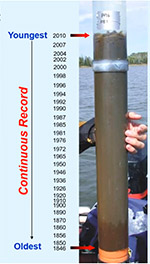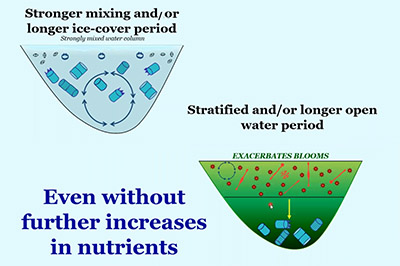
How Climate change and the reappearance of algae blooms are linked.
Editor's Note: This presentation took place in September 2021. I just found the video of the talk and felt it important enough to publish it at this time as part of our focus on the environment.
As northerners we Canadians love the extra month of summer and the milder winter weather we have had over the past few years. But for those of us who like to visit our many lakes for swimming and fishing each summer we are seeing more algae blooms, that blue green stuff floating on the water, at the same time?
 These are questions John Smol, a Queen’s university professor and the Canada Research Chair in Environmental Change, has been trying to answer. Smol spoke to the Rotary Club of Kingston on September 30, 2021.
These are questions John Smol, a Queen’s university professor and the Canada Research Chair in Environmental Change, has been trying to answer. Smol spoke to the Rotary Club of Kingston on September 30, 2021. Smol, has concluded, that a major determinant of an increase in blue-green algae is climate change as evidenced by longer summers and less ice in winter. But as he pointed out, critics bring forth a critique built on answering three questions.
Smol, has concluded, that a major determinant of an increase in blue-green algae is climate change as evidenced by longer summers and less ice in winter. But as he pointed out, critics bring forth a critique built on answering three questions.Science, however, has made it possible to determine, very precisely, answers to those kinds of questions. Just like rings in a tree trunk or cutting a core of glacial ice the environment of a 1000 years ago can be reconstructed.  So too can we extrapolate a lakes former climate from the mud that has settled on the bottom of the lake. Our Canadian lakes are around 12,000 years old, but we only need information for the past 200 years. Hence if we take a core sample and then slice it into .25 cm wafers, we can analyze all the types of life that were once in the air and water and in so doing recreate the climate by each year.
So too can we extrapolate a lakes former climate from the mud that has settled on the bottom of the lake. Our Canadian lakes are around 12,000 years old, but we only need information for the past 200 years. Hence if we take a core sample and then slice it into .25 cm wafers, we can analyze all the types of life that were once in the air and water and in so doing recreate the climate by each year.
 So too can we extrapolate a lakes former climate from the mud that has settled on the bottom of the lake. Our Canadian lakes are around 12,000 years old, but we only need information for the past 200 years. Hence if we take a core sample and then slice it into .25 cm wafers, we can analyze all the types of life that were once in the air and water and in so doing recreate the climate by each year.
So too can we extrapolate a lakes former climate from the mud that has settled on the bottom of the lake. Our Canadian lakes are around 12,000 years old, but we only need information for the past 200 years. Hence if we take a core sample and then slice it into .25 cm wafers, we can analyze all the types of life that were once in the air and water and in so doing recreate the climate by each year.Smol calls, climate change a “threat multiplier”, that is, no matter what the problem, it always makes it worse. What we are seeing is that even lakes that are low in phosphates are now creating algae blooms caused by more  days of sunlight penetrating the top layers of the water with the water achieving higher temperatures.
days of sunlight penetrating the top layers of the water with the water achieving higher temperatures.
 days of sunlight penetrating the top layers of the water with the water achieving higher temperatures.
days of sunlight penetrating the top layers of the water with the water achieving higher temperatures.Warmer water is lighter than colder water. Water in northern lakes forms three layers, hot at the top, cold at the bottom and a layer of moderate temperature in between. This is called “thermal stratification”. The middle layer, however, is important for the survival of the lakes fish stock. If the top layer grows in depth, the middle layer shrinks in size, and it can result in starving fish.
Fortunately, because we have winter, the water cycles at least twice a year, in the spring and fall. In tropical lakes, Like the African Great Lakes where it is hot all the time, so this layering effect is reducing the fish stock in the lakes as no cycling ever occurs.
Smol showed examples of two lakes with bad algae blooms, Lake of the Woods, located where Ontario, Manitoba and Minnesota meet and Dickson Lake in the middle of Algonquin Park.
 Algae blooms create many problems. They foul the shoreline, with obnoxious plants, create toxins which can kill wildlife or your pets, create a foul odor, but what is worse is the lack of oxygen, in the bottom cold layer and how this in turn can cause the P or phosphate levels to rise. This negatively affects the zooplankton, which move from the top to the bottom layers everyday and provide food for the fish we catch. If there is not enough oxygen, they stop going that the lowest levels with a detrimental effect on life in the lake.
Algae blooms create many problems. They foul the shoreline, with obnoxious plants, create toxins which can kill wildlife or your pets, create a foul odor, but what is worse is the lack of oxygen, in the bottom cold layer and how this in turn can cause the P or phosphate levels to rise. This negatively affects the zooplankton, which move from the top to the bottom layers everyday and provide food for the fish we catch. If there is not enough oxygen, they stop going that the lowest levels with a detrimental effect on life in the lake.His conclusion is that we must now consider lowering even further the nutrient levels we are using on the land and in our soaps, as well as take other steps if we are to save this threat to our lakes.

